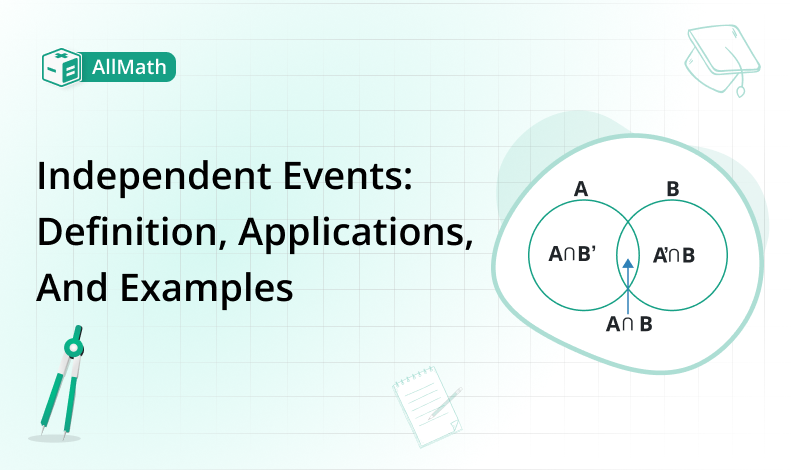To calculate result you have to disable your ad blocker first.
Independent Events: Definition, Applications, and Examples

Publish Date: 26 Sep, 2023
Table of Content
In probability theory, an event is a subset of possible outcomes that can occur during an experiment. An Independent event is the type of event in which outcomes do not affect each other. For example, when flipping a fair coin, each flip is an independent event. The outcome of one flip (heads or tails) does not affect the effects of the next flip.
In this article, we are going to explore independent events with many examples. We will prove its thermos and provide different mathematical solved examples.
Defining Independent Events
Two events are considered independent when the happening of one event does not influence the probability of the other event occurring. The probability of each event remains unaffected by the presence or absence of the other event.
Mathematically, two events A and B are independent if only if
- P(A|B) = P(A)
- P(B|A) = P(B)
- P(A ∩ B) = P(A) × P(B)
Examples of Independent Events:
- Rolling a die and getting a 6 then rolling the die again and getting a 3.
- Drawing a card from a deck and getting a heart, then drawing another card and getting a club.
- The probability of winning the lottery and the probability of being struck by lightning.
Determining the probability of independent events
Assume that we have two independent events. Event A and Event B. The probability of event A occurring is denoted as P(A). The probability of Event B occurring is denoted as P(B). Multiply P(A) by P(B) to calculate the probability of both events occurring.
It can be represented statistically as
P (A ∩ B) = P(A) × P(B)
Assume that the probability of Event A is 0.6 and the chance of happening of Event B is 0.4. The probability of both events occurring together would be 0.24.
Theorem of Independent Event
Two events A and B are independent if and only if the following conditions hold
- P(A|B) = P(A)
- P(B|A) = P(B)
- P(A ∩ B) = P(A) × P(B)
Proof:
Condition 1: let us assume that A and B are independent events.
We can write by using the definition of conditional probability as
P (A|B) = (A ∩ B) / P (B) ____ (1)
Since A and B are independent. We know that P (A ∩ B) = P (A) × P (B).
Substituting this into equation (1). We get
P (A|B) = (P (A) × P (B)) / P (B)
P (A|B) = P (A)
Hence, we have proved condition 1.
Condition 2.
Similarly, from the definition of conditional probability. We have
P (B|A) = P (A ∩ B) / P (A) ____ (2)
Using the fact that A and B are independent. We know that P (A ∩ B) = P(A) × P(B).
Substituting this into equation (2). We get
P (B|A) = (P (A) × P (B)) / P (A)
P (B|A) = P (B)
Thus, we have proved condition 2.
Condition 3.
We know that P (A ∩ B) = P (A) × P(B). Since A and B are independent.
Hence, condition 3 is already satisfied.
We have proven that if events A and B are independent, then the conditions 1, 2, and 3 hold.
Conversely, if the three conditions hold:
- P (A|B) = P (A)
- P (B|A) = P (B)
- P (A ∩ B) = P (A) × P(B)
We can use these conditions to prove that A and B are independent events.
P (A ∩ B) = P (A) × P (B)
Divide P (B) on both sides
P (A ∩ B) / P (B) = P (A)/P(B)
This equation is equivalent to
P (A|B) = P (A)
We can prove P (B|A) = P (B).
We have proved that two events A and B are independent if and only if the above three are satisfied.
Applications of Independent Events in Real life
Independent events have various real-life applications across different fields. Some applications are here.
- Stock Market Analysis
Independent events play a crucial role in analyzing stock market variation. The price movement of one stock is often considered independent of the price movement of other stocks. It allows investors to assess individual stock performance without being heavily influenced by the market as a whole.
- Sports Predictions
Independent events are often used in sports predictions. When predicting the outcome of a basketball game, each team's performance is typically considered an independent event, unaffected by the performance of other teams or previous games.
- Quality Control in Manufacturing
Independent events are applied in quality control processes. Testing random samples from a production line can be treated as independent events, ensuring that each sample's quality is assessed individually without being influenced by previous samples.
- Insurance Risk Assessment
Independent events are crucial in insurance risk assessment. When calculating the probability of an insured event, such as a vehicle accident or property damage. It is frequently assumed that these occurrences are independent and unaffected by previous occurrences.
Solved Example of Independent Events
Example
Determine the probability of getting tails on the coin flip and rolling an even number on the die.
Solution:
Probability of getting tails = P (T) = 1/2
Probability of rolling an even number = P (E) = 3/6 = 1/2
P (T ∩ E) = P (T) × P (E)
= (1/2) × (1/2) = 1/4
Conclusion
We have explored the definition of independent events with its mathematical representation in this article. We learned how to evaluate the probability of independent events. We have proved two events A and B are independent if and only if three axioms are satisfied. We looked at its real-life application. We did solve examples for you to understand this concept in a better manner.

